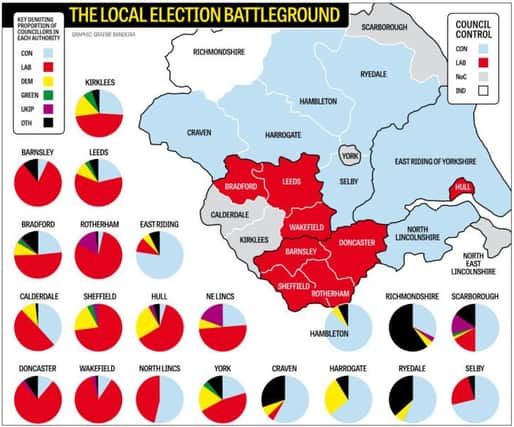Colin Mellors: Councils hang in political balance as election fight gets local


One third of council seats will be contested in most areas, but eight – East Riding, Hambleton, North Lincolnshire, Richmondshire, Ryedale, Scarborough, Selby and York – will be holding whole council elections.
This year, they are joined by a ninth with Doncaster becoming the first English metropolitan district to move away from the traditional pattern of “thirds” following a Government intervention. Councillors elected there will serve for just two years, rather than four, in order that, from 2017, mayoral and council elections coincide.
Advertisement
Hide AdAdvertisement
Hide AdThree areas – Doncaster, Hambleton and York – have new warding arrangements following electoral reviews. The council seats being contested were last fought in 2011, when Liberal Democrats were punished harshly for their party’s involvement in the Coalition Government. As a consequence, they lost more than 800 seats nationally and their poll share dropped by 10 points.
Losses included 10 in Hull, nine in Sheffield and six in Kirklees. No longer controlling any council in the region, and fighting from a low base, Liberal Democrat candidates will be hoping that next week’s local elections might bring some comfort to offset likely losses in the Westminster election.
By contrast, Labour and Conservatives face a tougher task defending their 2011 gains. In this regard, the main interest might be less how they fare relative to each other than the impact of the smaller parties on the results.
In 2011, Ukip won just eight council seats nationally. Last year, they picked up 161 seats, including 25 in Yorkshire and the Humber where they were also runners up in nearly 100 wards. Even if, as currently seems likely, they fall back this time they still have the potential to affect the outcome. Their presence is most likely to be felt in South Yorkshire and North East Lincolnshire.
Advertisement
Hide AdAdvertisement
Hide AdAlthough it is impossible for them to win outright, with just 21 seats being contested, in Rotherham a further swing of just 2.5 per cent could net a further 17 seats. With their poll ratings down significantly, this is highly unlikely but another strong showing next Thursday would have considerable impact on a council already in the national spotlight.
In North East Lincolnshire, again the arithmetic would not allow Ukip to win outright but a repeat of last year’s performance would put them close to becoming the leading party. Labour is only just short of a majority, although without a collapse in the Conservative vote, the council seems destined for another year without overall control.
Often, it is the councils in the Colne and Calder Valleys that provide the most tantalising prospects at local elections.
Unlike the metropolitan districts of South Yorkshire which have remained robustly Labour for most of their existence, Calderdale and Kirklees have come to accept being without a single party control as the norm.
Advertisement
Hide AdAdvertisement
Hide AdIn Kirklees, no seats changed hands last year. Although only three additional seats are needed for Labour to take control, it remains difficult to identify wards that are realistic prospects.
By contrast, Calderdale could emerge with a majority for the first time since 2000, with Labour requiring just one additional councillor. Three Conservative wards are vulnerable and Labour have taken all three at one or other of the last two local elections.
With a history of switching between Conservative and Labour control, North Lincolnshire might also be closely fought.
One other council worth watching, and one that contrasts with the blue that otherwise covers North Yorkshire’s political map, is York. Over the last two decades it has been variously Labour, Liberal Democrat and without a majority. The interest this time is fuelled by Labour’s loss last autumn of the slim majority that it achieved in 2011 as a consequence of party defections.
Advertisement
Hide AdAdvertisement
Hide AdInevitably, of course, feelings about national politics tend to dominate voting in local elections, but there are qualifications to this assertion.
In 2010, for example, nearly 10 per cent of electors in some constituencies cast their votes differently between local and parliamentary contests. How far this is explained by considered judgements about the merits of local and parliamentary candidates, and how far by tactical voting, is difficult to assess.
However, it does suggest that choosing what happens locally is not completely overshadowed by the fight for Downing Street.
Colin Mellors is Emeritus Professor of Politics at the University of York.